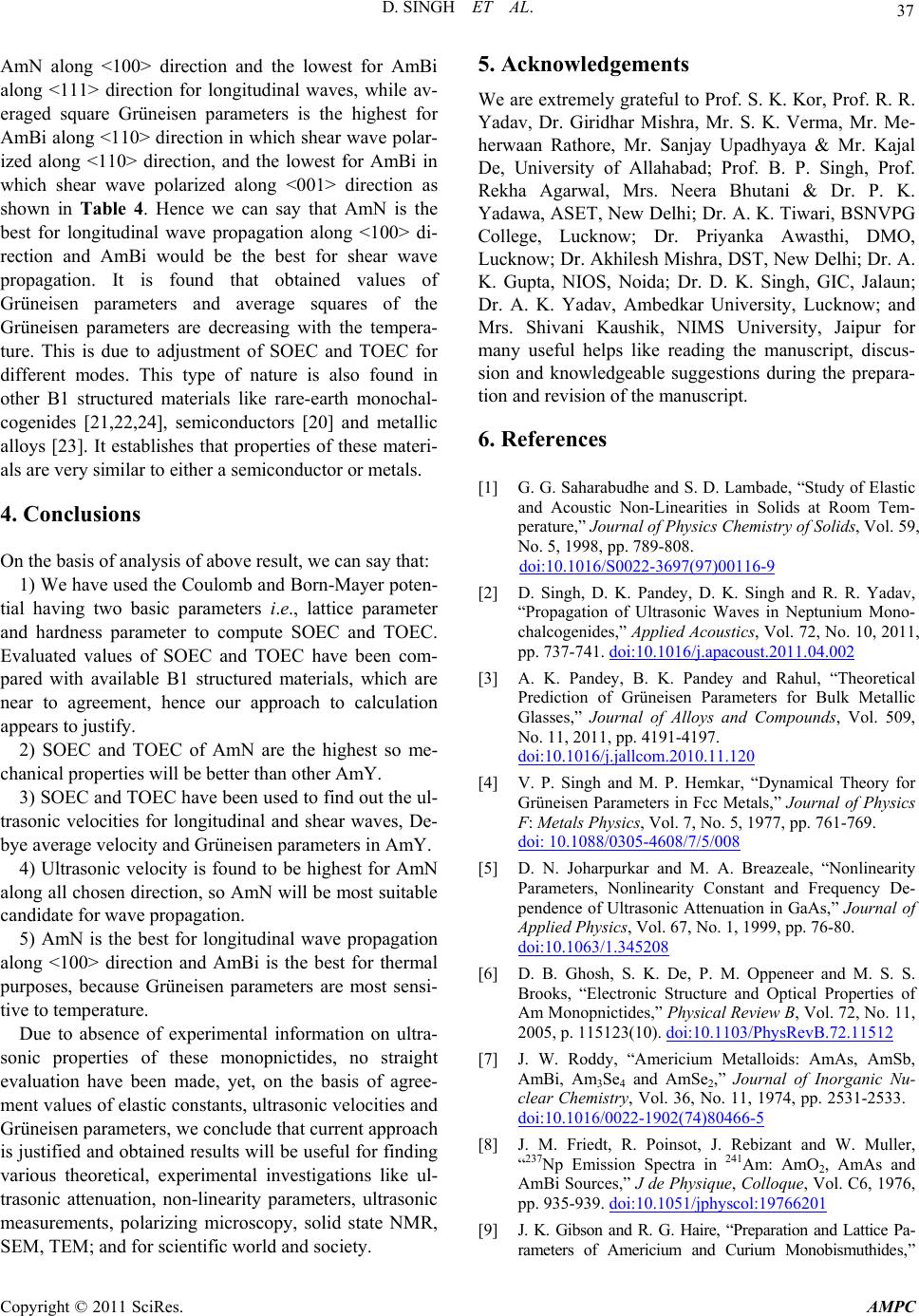
D. SINGH ET AL.
Copyright © 2011 SciRes. AMPC
37
5. Acknowledgements
AmN along <100> direction and the lowest for AmBi
along <111> direction for longitudinal waves, while av-
eraged square Grüneisen parameters is the highest for
AmBi along <110> direction in which shear wave polar-
ized along <110> direction, and the lowest for AmBi in
which shear wave polarized along <001> direction as
shown in Table 4. Hence we can say that AmN is the
best for longitudinal wave propagation along <100> di-
rection and AmBi would be the best for shear wave
propagation. It is found that obtained values of
Grüneisen parameters and average squares of the
Grüneisen parameters are decreasing with the tempera-
ture. This is due to adjustment of SOEC and TOEC for
different modes. This type of nature is also found in
other B1 structured materials like rare-earth monochal-
cogenides [21,22,24], semiconductors [20] and metallic
alloys [23]. It establishes that properties of these materi-
als are very similar to either a semiconductor or metals.
We are extremely grateful to Prof. S. K. Kor, Prof. R. R.
Yadav, Dr. Giridhar Mishra, Mr. S. K. Verma, Mr. Me-
herwaan Rathore, Mr. Sanjay Upadhyaya & Mr. Kajal
De, University of Allahabad; Prof. B. P. Singh, Prof.
Rekha Agarwal, Mrs. Neera Bhutani & Dr. P. K.
Yadawa, ASET, New Delhi; Dr. A. K. Tiwari, BSNVPG
College, Lucknow; Dr. Priyanka Awasthi, DMO,
Lucknow; Dr. Akhilesh Mishra, DST, New Delhi; Dr. A.
K. Gupta, NIOS, Noida; Dr. D. K. Singh, GIC, Jalaun;
Dr. A. K. Yadav, Ambedkar University, Lucknow; and
Mrs. Shivani Kaushik, NIMS University, Jaipur for
many useful helps like reading the manuscript, discus-
sion and knowledgeable suggestions during the prepara-
tion and revision of the manuscript.
6. References
[1] G. G. Saharabudhe and S. D. Lambade, “Study of Elastic
and Acoustic Non-Linearities in Solids at Room Tem-
perature,” Journal of Physics Chemistry of Solids, Vol. 59,
No. 5, 1998, pp. 789-808.
doi:10.1016/S0022-3697(97)00116-9
4. Conclusions
On the basis of analysis of above result, we can say that:
1) We have used the Coulomb and Born-Mayer poten-
tial having two basic parameters i.e., lattice parameter
and hardness parameter to compute SOEC and TOEC.
Evaluated values of SOEC and TOEC have been com-
pared with available B1 structured materials, which are
near to agreement, hence our approach to calculation
appears to justify.
[2] D. Singh, D. K. Pandey, D. K. Singh and R. R. Yadav,
“Propagation of Ultrasonic Waves in Neptunium Mono-
chalcogenides,” Applied Acoustics, Vol. 72, No. 10, 2011,
pp. 737-741. doi:10.1016/j.apacoust.2011.04.002
[3] A. K. Pandey, B. K. Pandey and Rahul, “Theoretical
Prediction of Grüneisen Parameters for Bulk Metallic
Glasses,” Journal of Alloys and Compounds, Vol. 509,
No. 11, 2011, pp. 4191-4197.
doi:10.1016/j.jallcom.2010.11.120
2) SOEC and TOEC of AmN are the highest so me-
chanical properties will be better than other AmY. [4] V. P. Singh and M. P. Hemkar, “Dynamical Theory for
Grüneisen Parameters in Fcc Metals,” Journal of Physics
F: Metals Physics, Vol. 7, No. 5, 1977, pp. 761-769.
doi: 10.1088/0305-4608/7/5/008
3) SOEC and TOEC have been used to find out the ul-
trasonic velocities for longitudinal and shear waves, De-
bye average velocity and Grüneisen parameters in AmY.
4) Ultrasonic velocity is found to be highest for AmN
along all chosen direction, so AmN will be most suitable
candidate for wave propagation.
[5] D. N. Joharpurkar and M. A. Breazeale, “Nonlinearity
Parameters, Nonlinearity Constant and Frequency De-
pendence of Ultrasonic Attenuation in GaAs,” Journal of
Applied Physics, Vol. 67, No. 1, 1999, pp. 76-80.
doi:10.1063/1.345208
5) AmN is the best for longitudinal wave propagation
along <100> direction and AmBi is the best for thermal
purposes, because Grüneisen parameters are most sensi-
tive to temperature.
[6] D. B. Ghosh, S. K. De, P. M. Oppeneer and M. S. S.
Brooks, “Electronic Structure and Optical Properties of
Am Monopnictides,” Physical Review B, Vol. 72, No. 11,
2005, p. 115123(10). doi:10.1103/PhysRevB.72.11512
Due to absence of experimental information on ultra-
sonic properties of these monopnictides, no straight
evaluation have been made, yet, on the basis of agree-
ment values of elastic constants, ultrason ic velocities and
Grüneisen parameters, we conclude that current approach
is justified and obtained results will be usefu l for finding
various theoretical, experimental investigations like ul-
trasonic attenuation, non-linearity parameters, ultrasonic
measurements, polarizing microscopy, solid state NMR,
SEM, TEM; and for scientific world and society.
[7] J. W. Roddy, “Americium Metalloids: AmAs, AmSb,
AmBi, Am3Se4 and AmSe2,” Journal of Inorganic Nu-
clear Chemistry, Vol. 36, No. 11, 1974, pp. 2531-2533.
doi:10.1016/0022-1902(74)80466-5
[8] J. M. Friedt, R. Poinsot, J. Rebizant and W. Muller,
“237Np Emission Spectra in 241Am: AmO2, AmAs and
AmBi Sources,” J de Physique, Colloque, Vol. C6, 1976,
pp. 935-939. doi:10.1051/jphyscol:19766201
[9] J. K. Gibson and R. G. Haire, “Preparation and Lattice Pa-
rameters of Americium and Curium Monobismuthides,”